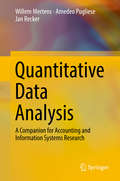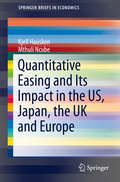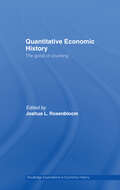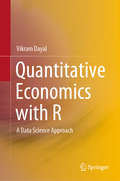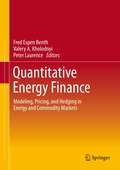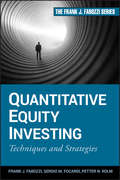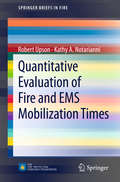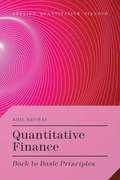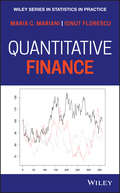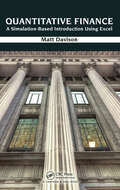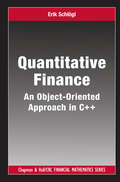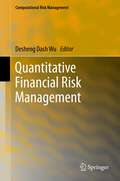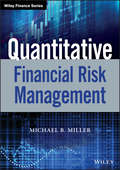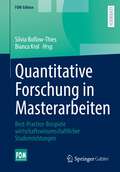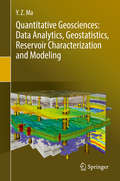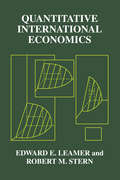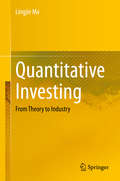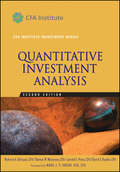- Table View
- List View
Quantitative Data Analysis
by Jan Recker Willem Mertens Amedeo PuglieseThis book offers postgraduate and early career researchers in accounting and information systems a guide to choosing, executing and reporting appropriate data analysis methods to answer their research questions. It provides readers with a basic understanding of the steps that each method involves, and of the facets of the analysis that require special attention. Rather than presenting an exhaustive overview of the methods or explaining them in detail, the book serves as a starting point for developing data analysis skills: it provides hands-on guidelines for conducting the most common analyses and reporting results, and includes pointers to more extensive resources. Comprehensive yet succinct, the book is brief and written in a language that everyone can understand - from students to those employed by organizations wanting to study the context in which they work. It also serves as a refresher for researchers who have learned data analysis techniques previously but who need a reminder for the specific study they are involved in.
Quantitative Easing and Its Impact in the US, Japan, the UK and Europe
by Kjell Hausken Mthuli NcubeThis volume empirically analyzes the effects of quantitative easing (QE) on interest rates and the economy in the US, Japan, UK and Europe. Using an event-study methodology, the authors find that the measures undertaken by the Federal Reserve and Bank of England, which focus primarily on bond purchases, are much more effective in lowering interest rates than those undertaken by the Bank of Japan and the European Central Bank, which have relied more heavily on lending to private financial institutions. Using large Bayesian vector autoregression (BVAR) models they also analyze the impact of QE on the wider economy. They produce no-QE counterfactual forecasts that are compared with their corresponding baseline forecasts, incorporating the effects of QE on government bond spreads. Despite the failure of stimulating economic activities as a whole, the simulation results suggest that the unconventional monetary policies have a positive influence on industrial production in the US, UK and Japan. The authors' analysis finds that QE contributes to the reduction in unemployment in the US and Japan, and a rise in inflation-expectations in the US, UK and Euro zone. However, evidence on QE's effect on house prices, stock prices, consumer confidence, and exchange rate, is mixed and thus inconclusive.
Quantitative Economic History: The good of counting
by Joshua L. RosenbloomThe essays in this book use the analytical tools and theoretical framework of economics to interpret quantitative historical evidence, offering new ways to approach historical issues and suggesting entirely new types of evidence outside conventional archives. Rosenbloom has gathered together seven essays from leading quantitative economic historian
Quantitative Economics with R: A Data Science Approach
by Vikram DayalThis book provides a contemporary treatment of quantitative economics, with a focus on data science. The book introduces the reader to R and RStudio, and uses expert Hadley Wickham’s tidyverse package for different parts of the data analysis workflow. After a gentle introduction to R code, the reader’s R skills are gradually honed, with the help of “your turn” exercises. At the heart of data science is data, and the book equips the reader to import and wrangle data, (including network data). Very early on, the reader will begin using the popular ggplot2 package for visualizing data, even making basic maps. The use of R in understanding functions, simulating difference equations, and carrying out matrix operations is also covered. The book uses Monte Carlo simulation to understand probability and statistical inference, and the bootstrap is introduced. Causal inference is illuminated using simulation, data graphs, and R code for applications with real economic examples, covering experiments, matching, regression discontinuity, difference-in-difference, and instrumental variables. The interplay of growth related data and models is presented, before the book introduces the reader to time series data analysis with graphs, simulation, and examples. Lastly, two computationally intensive methods—generalized additive models and random forests (an important and versatile machine learning method)—are introduced intuitively with applications. The book will be of great interest to economists—students, teachers, and researchers alike—who want to learn R. It will help economics students gain an intuitive appreciation of applied economics and enjoy engaging with the material actively, while also equipping them with key data science skills.
Quantitative Energy Finance: Modeling, Pricing, and Hedging in Energy and Commodity Markets
by Fred Espen Benth Valery Kholodnyi Peter LaurenceFinance and energy markets have been an active scientific field for some time, even though the development and applications of sophisticated quantitative methods in these areas are relatively new--and referred to in a broader context as energy finance. Energy finance is often viewed as a branch of mathematical finance, yet this area continues to provide a rich source of issues that are fuelling new and exciting research developments. Based on a special thematic year at the Wolfgang Pauli Institute (WPI) in Vienna, Austria, this edited collection features cutting-edge research from leading scientists in the fields of energy and commodity finance. Topics discussed include modeling and analysis of energy and commodity markets, derivatives hedging and pricing, and optimal investment strategies and modeling of emerging markets, such as power and emissions. The book also confronts the challenges one faces in energy markets from a quantitative point of view, as well as the recent advances in solving these problems using advanced mathematical, statistical and numerical methods. By addressing the emerging area of quantitative energy finance, this volume will serve as a valuable resource for graduate-level students and researchers studying financial mathematics, risk management, or energy finance.
Quantitative Energy Finance: Recent Trends and Developments
by Fred Espen Benth Almut E. D. VeraartPower markets are undergoing a major transformation from gas and oil-fueled generation toward renewable electricity production from wind and solar sources. Simultaneously, there is an increasing demand for electrification, coupled with long-term climate-induced weather changes. The uncertainties confronting energy market participants require sophisticated modelling techniques to effectively understand risk, many of which are covered in this book.Comprising invited papers by high-profile researchers, this volume examines the empirical aspects of forward and futures prices, uncovering patterns of noise factors in various European electricity markets. Additionally, it delves into the recent, influential classes of Hawkes and trawl processes, emphasizing their significance in energy markets. The impact of renewables on energy market prices is a pivotal concern for both producers and consumers. Mean-field games provide a powerful mathematical framework for this, and a dedicated chapter outlining their dynamics is included in the book. The book also explores structural financial products and their connection to climate risk as a risk management tool, underscoring the essential need for a comprehensive understanding of these products in the realm of "green finance," to which the energy industry is integral. Lastly, the book thoroughly analyzes spatial smoothing and power purchase (PPA) contracts, addressing central issues in energy system planning and financial operations.Tailored for researchers, PhD students, and industry energy analysts, this volume equips readers with insights and tools to navigate the constantly evolving energy market landscape. It serves as a sequel to the earlier Quantitative Energy Finance book, featuring all-new chapters.
Quantitative Equity Investing
by Frank J. Fabozzi Petter N. Kolm Sergio M. FocardiA comprehensive look at the tools and techniques used in quantitative equity managementSome books attempt to extend portfolio theory, but the real issue today relates to the practical implementation of the theory introduced by Harry Markowitz and others who followed. The purpose of this book is to close the implementation gap by presenting state-of-the art quantitative techniques and strategies for managing equity portfolios.Throughout these pages, Frank Fabozzi, Sergio Focardi, and Petter Kolm address the essential elements of this discipline, including financial model building, financial engineering, static and dynamic factor models, asset allocation, portfolio models, transaction costs, trading strategies, and much more. They also provide ample illustrations and thorough discussions of implementation issues facing those in the investment management business and include the necessary background material in probability, statistics, and econometrics to make the book self-contained.Written by a solid author team who has extensive financial experience in this areaPresents state-of-the art quantitative strategies for managing equity portfoliosFocuses on the implementation of quantitative equity asset managementOutlines effective analysis, optimization methods, and risk modelsIn today's financial environment, you have to have the skills to analyze, optimize and manage the risk of your quantitative equity investments. This guide offers you the best information available to achieve this goal.
Quantitative Equity Portfolio Management: Modern Techniques and Applications (Chapman and Hall/CRC Financial Mathematics Series)
by Edward E. Qian Ronald H. Hua Eric H. SorensenQuantitative equity portfolio management combines theories and advanced techniques from several disciplines, including financial economics, accounting, mathematics, and operational research. While many texts are devoted to these disciplines, few deal with quantitative equity investing in a systematic and mathematical framework that is suitable for
Quantitative Evaluation of Fire and EMS Mobilization Times
by Robert Upson Kathy A. NotarianniQuantitative Evaluation of Fire and EMS Mobilization Times presents comprehensive empirical data on fire emergency and EMS call processing and turnout times, and aims to improve the operational benchmarks of NFPA peer consensus standards through a close examination of real-world data. The book also identifies and analyzes the elements that can influence EMS mobilization response times. Quantitative Evaluation of Fire and EMS Mobilization Times is intended for practitioners as a tool for analyzing fire emergency response times and developing methods for improving them. Researchers working in a related field will also find the book valuable.
Quantitative Finance
by Adil ReghaiThe series of recent financial crises have thrown open the world of quantitative finance and financial modeling. This book brings together proven and new methodologies from finance, physics and engineering, along with years of industry and academic experience to provide a cookbook of models for dealing with the challenges of today's markets.
Quantitative Finance (Statistics in Practice)
by Maria C. Mariani Ionut FlorescuPresents a multitude of topics relevant to the quantitative finance community by combining the best of the theory with the usefulness of applications Written by accomplished teachers and researchers in the field, this book presents quantitative finance theory through applications to specific practical problems and comes with accompanying coding techniques in R and MATLAB, and some generic pseudo-algorithms to modern finance. It also offers over 300 examples and exercises that are appropriate for the beginning student as well as the practitioner in the field. The Quantitative Finance book is divided into four parts. Part One begins by providing readers with the theoretical backdrop needed from probability and stochastic processes. We also present some useful finance concepts used throughout the book. In part two of the book we present the classical Black-Scholes-Merton model in a uniquely accessible and understandable way. Implied volatility as well as local volatility surfaces are also discussed. Next, solutions to Partial Differential Equations (PDE), wavelets and Fourier transforms are presented. Several methodologies for pricing options namely, tree methods, finite difference method and Monte Carlo simulation methods are also discussed. We conclude this part with a discussion on stochastic differential equations (SDE’s). In the third part of this book, several new and advanced models from current literature such as general Lvy processes, nonlinear PDE's for stochastic volatility models in a transaction fee market, PDE's in a jump-diffusion with stochastic volatility models and factor and copulas models are discussed. In part four of the book, we conclude with a solid presentation of the typical topics in fixed income securities and derivatives. We discuss models for pricing bonds market, marketable securities, credit default swaps (CDS) and securitizations. Classroom-tested over a three-year period with the input of students and experienced practitioners Emphasizes the volatility of financial analyses and interpretations Weaves theory with application throughout the book Utilizes R and MATLAB software programs Presents pseudo-algorithms for readers who do not have access to any particular programming system Supplemented with extensive author-maintained web site that includes helpful teaching hints, data sets, software programs, and additional content Quantitative Finance is an ideal textbook for upper-undergraduate and beginning graduate students in statistics, financial engineering, quantitative finance, and mathematical finance programs. It will also appeal to practitioners in the same fields.
Quantitative Finance For Dummies
by Steve BellAn accessible, thorough introduction to quantitative finance Does the complex world of quantitative finance make you quiver? You're not alone! It's a tough subject for even high-level financial gurus to grasp, but Quantitative Finance For Dummies offers plain-English guidance on making sense of applying mathematics to investing decisions. With this complete guide, you'll gain a solid understanding of futures, options and risk, and get up-to-speed on the most popular equations, methods, formulas and models (such as the Black-Scholes model) that are applied in quantitative finance. Also known as mathematical finance, quantitative finance is the field of mathematics applied to financial markets. It's a highly technical discipline—but almost all investment companies and hedge funds use quantitative methods. This fun and friendly guide breaks the subject of quantitative finance down to easily digestible parts, making it approachable for personal investors and finance students alike. With the help of Quantitative Finance For Dummies, you'll learn the mathematical skills necessary for success with quantitative finance, the most up-to-date portfolio and risk management applications and everything you need to know about basic derivatives pricing. Covers the core models, formulas and methods used in quantitative finance Includes examples and brief exercises to help augment your understanding of QF Provides an easy-to-follow introduction to the complex world of quantitative finance Explains how QF methods are used to define the current market value of a derivative security Whether you're an aspiring quant or a top-tier personal investor, Quantitative Finance For Dummies is your go-to guide for coming to grips with QF/risk management.
Quantitative Finance with Python: A Practical Guide to Investment Management, Trading, and Financial Engineering (Chapman and Hall/CRC Financial Mathematics Series)
by Chris KelliherQuantitative Finance with Python: A Practical Guide to Investment Management, Trading and Financial Engineering bridges the gap between the theory of mathematical finance and the practical applications of these concepts for derivative pricing and portfolio management. The book provides students with a very hands-on, rigorous introduction to foundational topics in quant finance, such as options pricing, portfolio optimization and machine learning. Simultaneously, the reader benefits from a strong emphasis on the practical applications of these concepts for institutional investors. Features Useful as both a teaching resource and as a practical tool for professional investors. Ideal textbook for first year graduate students in quantitative finance programs, such as those in master’s programs in Mathematical Finance, Quant Finance or Financial Engineering. Includes a perspective on the future of quant finance techniques, and in particular covers some introductory concepts of Machine Learning. Free-to-access repository with Python codes available at www.routledge.com/ 9781032014432.
Quantitative Finance: A Simulation-Based Introduction Using Excel
by Matt DavisonTeach Your Students How to Become Successful Working QuantsQuantitative Finance: A Simulation-Based Introduction Using Excel provides an introduction to financial mathematics for students in applied mathematics, financial engineering, actuarial science, and business administration. The text not only enables students to practice with the basic techn
Quantitative Finance: An Object-Oriented Approach in C++ (Chapman and Hall/CRC Financial Mathematics Series)
by Erik SchloglQuantitative Finance: An Object-Oriented Approach in C++ provides readers with a foundation in the key methods and models of quantitative finance. Keeping the material as self-contained as possible, the author introduces computational finance with a focus on practical implementation in C++. Through an approach based on C++ classes and templates, the text highlights the basic principles common to various methods and models while the algorithmic implementation guides readers to a more thorough, hands-on understanding. By moving beyond a purely theoretical treatment to the actual implementation of the models using C++, readers greatly enhance their career opportunities in the field. The book also helps readers implement models in a trading or research environment. It presents recipes and extensible code building blocks for some of the most widespread methods in risk management and option pricing. Web ResourceThe author’s website provides fully functional C++ code, including additional C++ source files and examples. Although the code is used to illustrate concepts (not as a finished software product), it nevertheless compiles, runs, and deals with full, rather than toy, problems. The website also includes a suite of practical exercises for each chapter covering a range of difficulty levels and problem complexity.
Quantitative Financial Risk Management
by Desheng Dash WuThe bulk of this volume deals with the four main aspects of risk management: market risk, credit risk, risk management - in macro-economy as well as within companies. It presents a number of approaches and case studies directed at applying risk management to diverse business environments. Included are traditional market and credit risk management models such as the Black-Scholes Option Pricing Model, the Vasicek Model, Factor models, CAPM models, GARCH models, KMV models and credit scoring models.
Quantitative Financial Risk Management: Applying Financial Models And Mathematical Techniques (Wiley Finance)
by Michael B. MillerA mathematical guide to measuring and managing financial risk. Our modern economy depends on financial markets. Yet financial markets continue to grow in size and complexity. As a result, the management of financial risk has never been more important. Quantitative Financial Risk Management introduces students and risk professionals to financial risk management with an emphasis on financial models and mathematical techniques. Each chapter provides numerous sample problems and end of chapter questions. The book provides clear examples of how these models are used in practice and encourages readers to think about the limits and appropriate use of financial models. Topics include: • Value at risk• Stress testing• Credit risk• Liquidity risk• Factor analysis• Expected shortfall• Copulas• Extreme value theory• Risk model backtesting• Bayesian analysis• . . . and much more
Quantitative Financial Risk Management: Theory and Practice (Frank J. Fabozzi Series)
by Constantin Zopounidis Emilios GalariotisA Comprehensive Guide to Quantitative Financial Risk Management Written by an international team of experts in the field, Quantitative Financial Risk Management: Theory and Practice provides an invaluable guide to the most recent and innovative research on the topics of financial risk management, portfolio management, credit risk modeling, and worldwide financial markets. This comprehensive text reviews the tools and concepts of financial management that draw on the practices of economics, accounting, statistics, econometrics, mathematics, stochastic processes, and computer science and technology. Using the information found in Quantitative Financial Risk Management can help professionals to better manage, monitor, and measure risk, especially in today's uncertain world of globalization, market volatility, and geo-political crisis. Quantitative Financial Risk Management delivers the information, tools, techniques, and most current research in the critical field of risk management. This text offers an essential guide for quantitative analysts, financial professionals, and academic scholars.
Quantitative Forschung in Masterarbeiten: Best-Practice-Beispiele wirtschaftswissenschaftlicher Studienrichtungen (FOM-Edition)
by Bianca Krol Silvia Boßow-ThiesDieses Buch unterstützt Studierende bei der Anfertigung wissenschaftlicher Arbeiten mit einem quantitativen Fokus. Mittels Best-Practice-Beispielen aus Masterarbeiten werden das wissenschaftliche Vorgehen sowie die Anwendung unterschiedlicher quantitativer Methoden anwendungsnah präsentiert. Die Masterarbeiten verdeutlichen ein breites quantitatives Methodenspektrum von strukturentdeckenden Verfahren wie Clusteranalyse oder Conjoint-Analyse bis hin zu strukturprüfenden Verfahren wie Interventionsstudien, Regressions- oder Mehrgleichungsstrukturanalysen. Die Analyseschritte sind über die verwendeten R Codes nachvollziehbar dargestellt. Die Masterarbeiten wurden mit Hintergrundinformationen, Tipps sowie Hinweisen auf alternative Vorgehensweisen angereichert. Der empirisch-quantitative Forschungsprozess wird Schritt für Schritt erklärt und es wird erläutert, wann ein qualitativer Forschungsansatz für die Lösung des vorliegenden Forschungsproblems besser geeignet ist. Ein Ausblick auf zukünftige Herausforderungen und Möglichkeiten im Rahmen von quantitativen Abschlussarbeiten rundet das Buch ab.
Quantitative Fund Management
by M. A. H. Dempster, Georg Pflug, and Gautam MitraThe First Collection That Covers This Field at the Dynamic Strategic and One-Period Tactical Levels. Addressing the imbalance between research and practice, Quantitative Fund Management presents leading-edge theory and methods, along with their application in practical problems encountered in the fund management industry. A Current Snapshot of State-of-the-Art Applications of Dynamic Stochastic Optimization Techniques to Long-Term Financial Planning - The first part of the book initially looks at how the quantitative techniques of the equity industry are shifting from basic Markowitz mean-variance portfolio optimization to risk management and trading applications. This section also explores novel aspects of lifetime individual consumption investment problems, fixed-mix portfolio rebalancing allocation strategies, debt management for funding mortgages and national debt, and guaranteed return fund construction. Up-to-Date Overview of Tactical Financial Planning and Risk Management - The second section covers nontrivial computational approaches to tactical fund management. This part focuses on portfolio construction and risk management at the individual security or fund manager level over the period up to the next portfolio rebalance. It discusses non-Gaussian returns, new risk-return tradeoffs, and the robustness of benchmarks and portfolio decisions. The Future Use of Quantitative Techniques in Fund Management - With contributions from well-known academics and practitioners, this volume will undoubtedly foster the recognition and wider acceptance of stochastic optimization techniques in financial practice.
Quantitative Geosciences: Data Analytics, Geostatistics, Reservoir Characterization and Modeling
by Y. Z. MaEarth science is becoming increasingly quantitative in the digital age. Quantification of geoscience and engineering problems underpins many of the applications of big data and artificial intelligence. This book presents quantitative geosciences in three parts. Part 1 presents data analytics using probability, statistical and machine-learning methods. Part 2 covers reservoir characterization using several geoscience disciplines: including geology, geophysics, petrophysics and geostatistics. Part 3 treats reservoir modeling, resource evaluation and uncertainty analysis using integrated geoscience, engineering and geostatistical methods. As the petroleum industry is heading towards operating oil fields digitally, a multidisciplinary skillset is a must for geoscientists who need to use data analytics to resolve inconsistencies in various sources of data, model reservoir properties, evaluate uncertainties, and quantify risk for decision making. This book intends to serve as a bridge for advancing the multidisciplinary integration for digital fields. The goal is to move beyond using quantitative methods individually to an integrated descriptive-quantitative analysis. In big data, everything tells us something, but nothing tells us everything. This book emphasizes the integrated, multidisciplinary solutions for practical problems in resource evaluation and field development.
Quantitative International Economics
by Robert M. Stern Edward E. LeamerThis distinctive book sets forth, on an advanced level, various methods for the quantitative measurement of important relationships at issue in areas of the balance of payments and international trade and welfare. The results achieved in recent studies are presented and the directions for new research are indicated. This book is composed of two main parts.Part I deals with the balance of payments and consists of the first half of the book. One of the longest and almost important chapters of this part talks about, at length the time-series analysis of the demand for imports and exports from the point of view of an individual country. This subject has a long and somewhat checkered history dating from the 1940's, when a number of estimates using least squares multiple regression methods were made of import and export demand functions for the interwar period. The noteworthy feature of many of these estimates was that they suggested relatively low price elasticities of demand in international trade. The implication was thus drawn that the international price mechanism could not be relied on for balance-of payments adjustment purposes.This book talks about the topics of theory and measurement of the elasticity of substitution in international trade, estimating the international capital movements, and forecasting and policy analysis with econometric models. Part II deals with international trade and welfare. While, there are many other books dealing with trade theory, this title focuses on a narrower range of topics that are not always mentioned or understood by individuals, such as the theory and measurement of trade dependence and interdependence, the analysis of the component factors a country has that affects how its export growth is over time, and the welfare effects of trade liberalizationThis book serves as a guide and reference work for economics graduate students, academicians, and practicing economists in private and governmental circles. They will find this book
Quantitative Investing for the Global Markets: Strategies, Tactics And Advanced Analytical Techniques
by Peter CarmanOver the past several years, the field of international investing has been transformed by a host of new, state-of-the-art techniques. Quantitative Investing for the Global Markets is the definitive handbook for money and portfolio managers, research analysts, pension consultants, corporate treasurers, and other professionals seeking a competitive edge in the global investment marketplace. Topics include: international asset allocation; optimum diversification levels; style analysis and evaluation; market neutral strategies; global stock valuation; advanced strategies for hedging currency risk; international benchmarking; etc.
Quantitative Investing: From Theory to Industry
by Lingjie MaThis book provides readers with a systematic approach to quantitative investments and bridges the gap between theory and practice, equipping students to more seamlessly enter the world of industry. A successful quantitative investment strategy requires an individual to possess a deep understanding of the financial markets, investment theories and econometric modelings, as well as the ability to program and analyze real-world data sets. In order to connect finance theories and practical industry experience, each chapter begins with a real-world finance case study. The rest of the chapter introduces fundamental insights and theories, and teaches readers to use statistical models and R programming to analyze real-world data, therefore grounding the learning process in application. Additionally, each chapter profiles significant figures in investment and quantitative studies, so that readers can more fully understand the history of the discipline. This volume will be particularly useful to advanced students and practitioners in finance and investments.
Quantitative Investment Analysis
by Richard A. David E. Dennis W. Jerald E. Defusco Mcleavey Pinto Runkle Anson Mark J.In the Second Edition of Quantitative Investment Analysis, financial experts Richard DeFusco, Dennis McLeavey, Jerald Pinto, and David Runkle outline the tools and techniques needed to understand and apply quantitative methods to today's investment process. Now, in Quantitative Investment Analysis Workbook, Second Edition, they offer you a wealth of practical information and exercises that will further enhance your understanding of this discipline. This essential study guide--which parallels the main book chapter by chapter--contains challenging problems and a complete set of solutions as well as concise learning outcome statements and summary overviews. If you're looking to successfully navigate today's dynamic investment environment, the lessons found within these pages can show you how. Topics reviewed include: The time value of money Discounted cash flow Probability distributions Sampling and estimation Hypothesis testing Multiple regression Time-series analysis And much more
